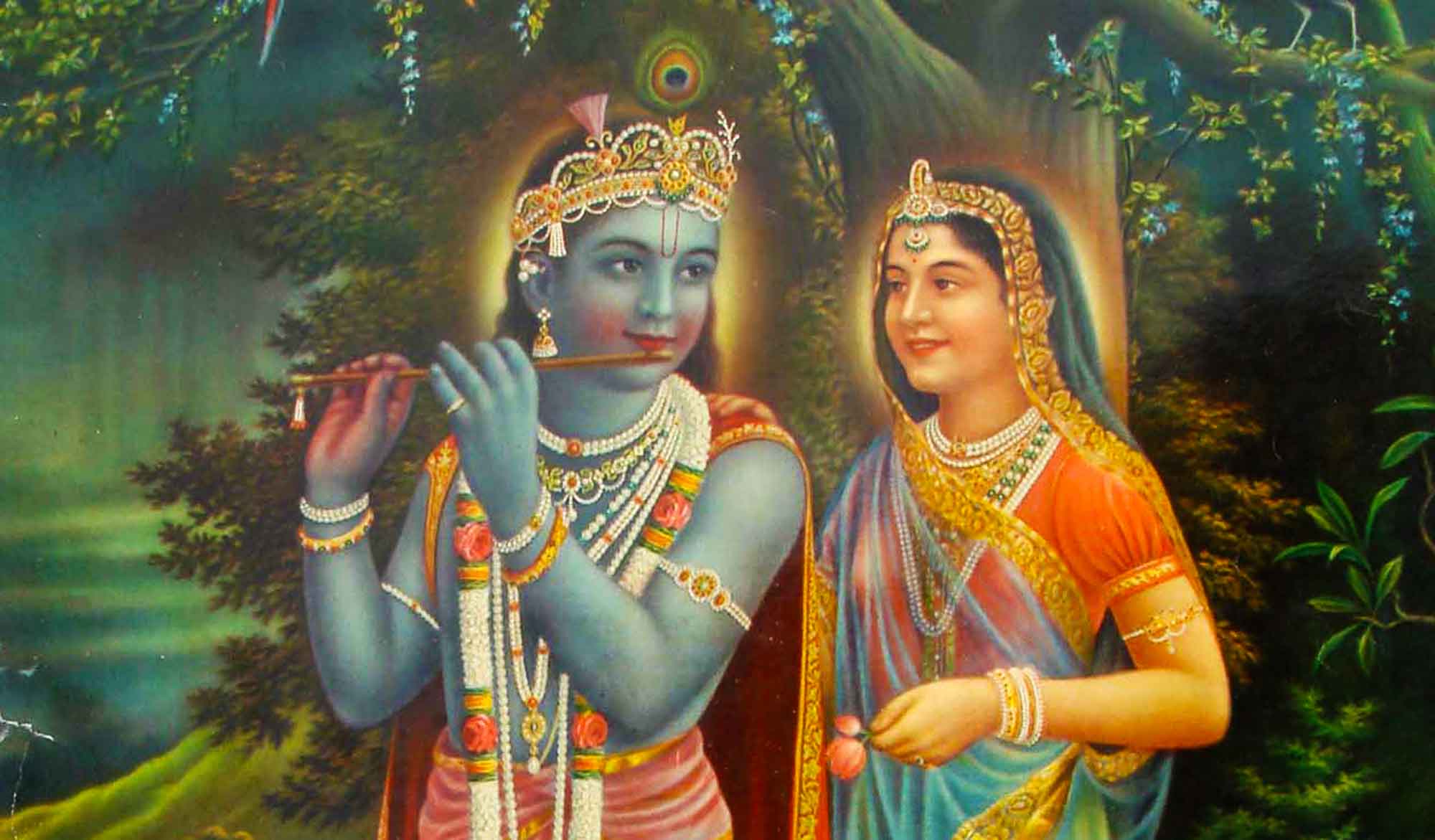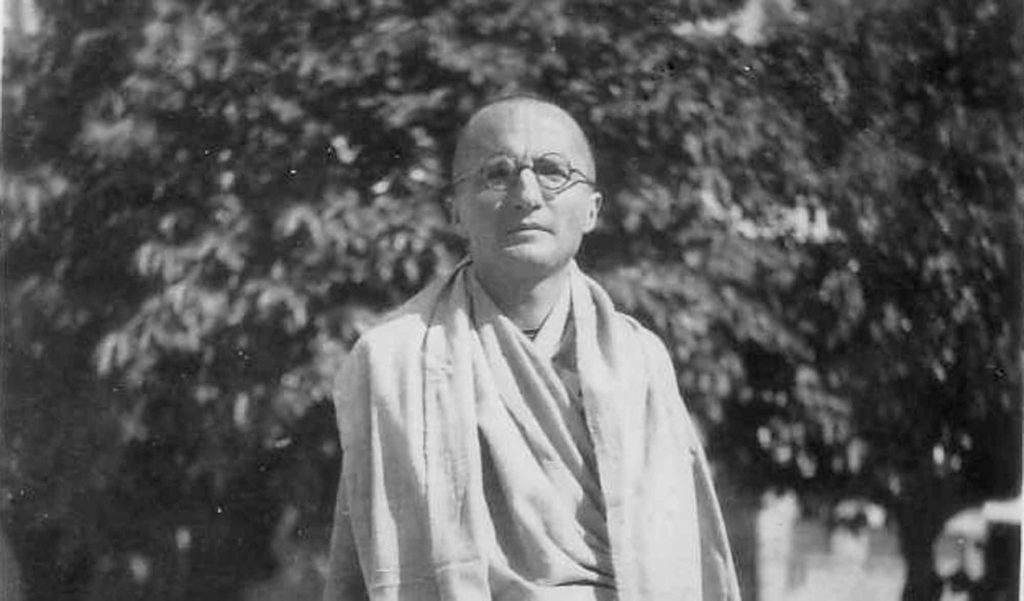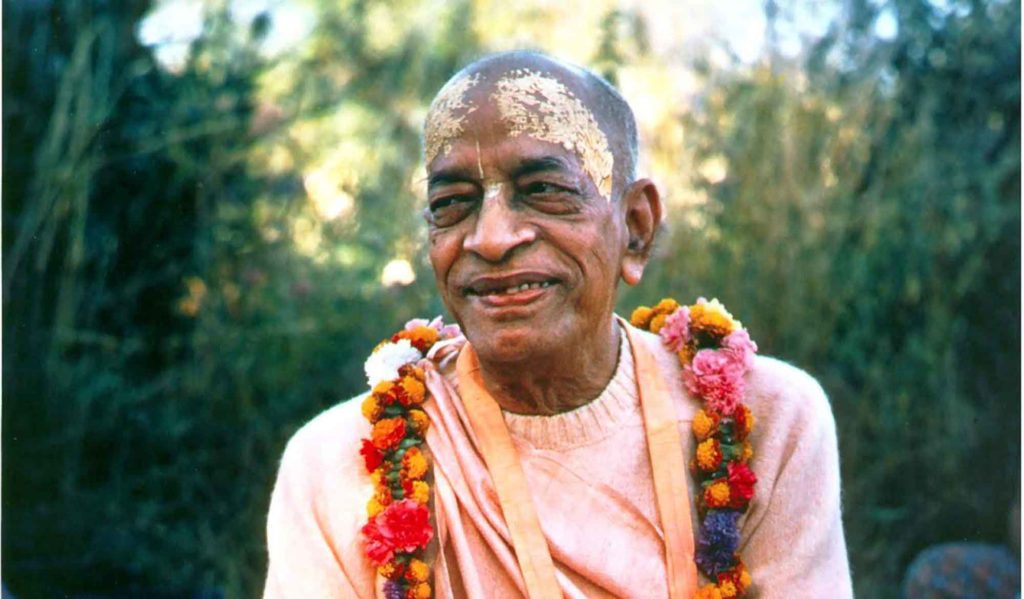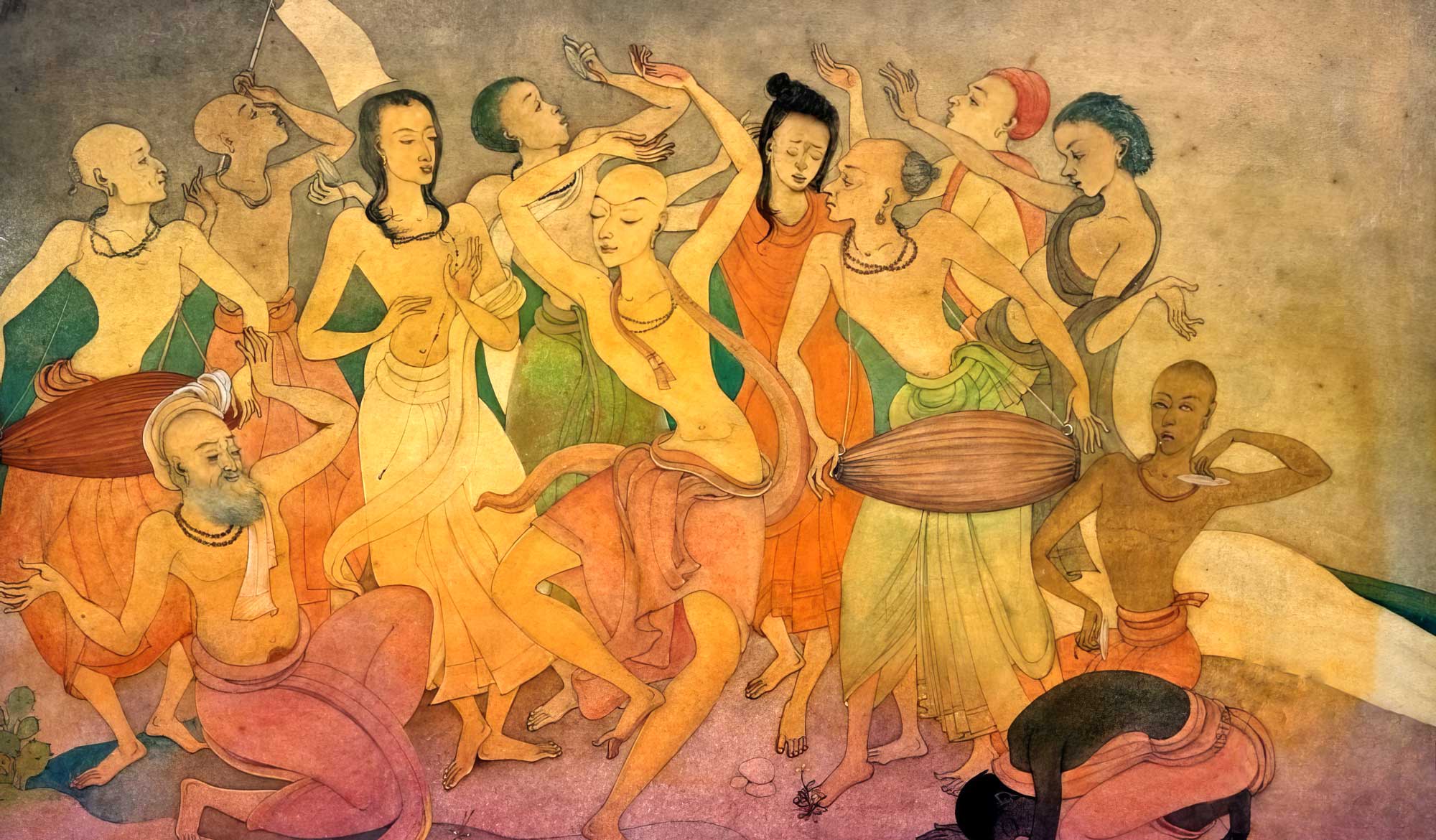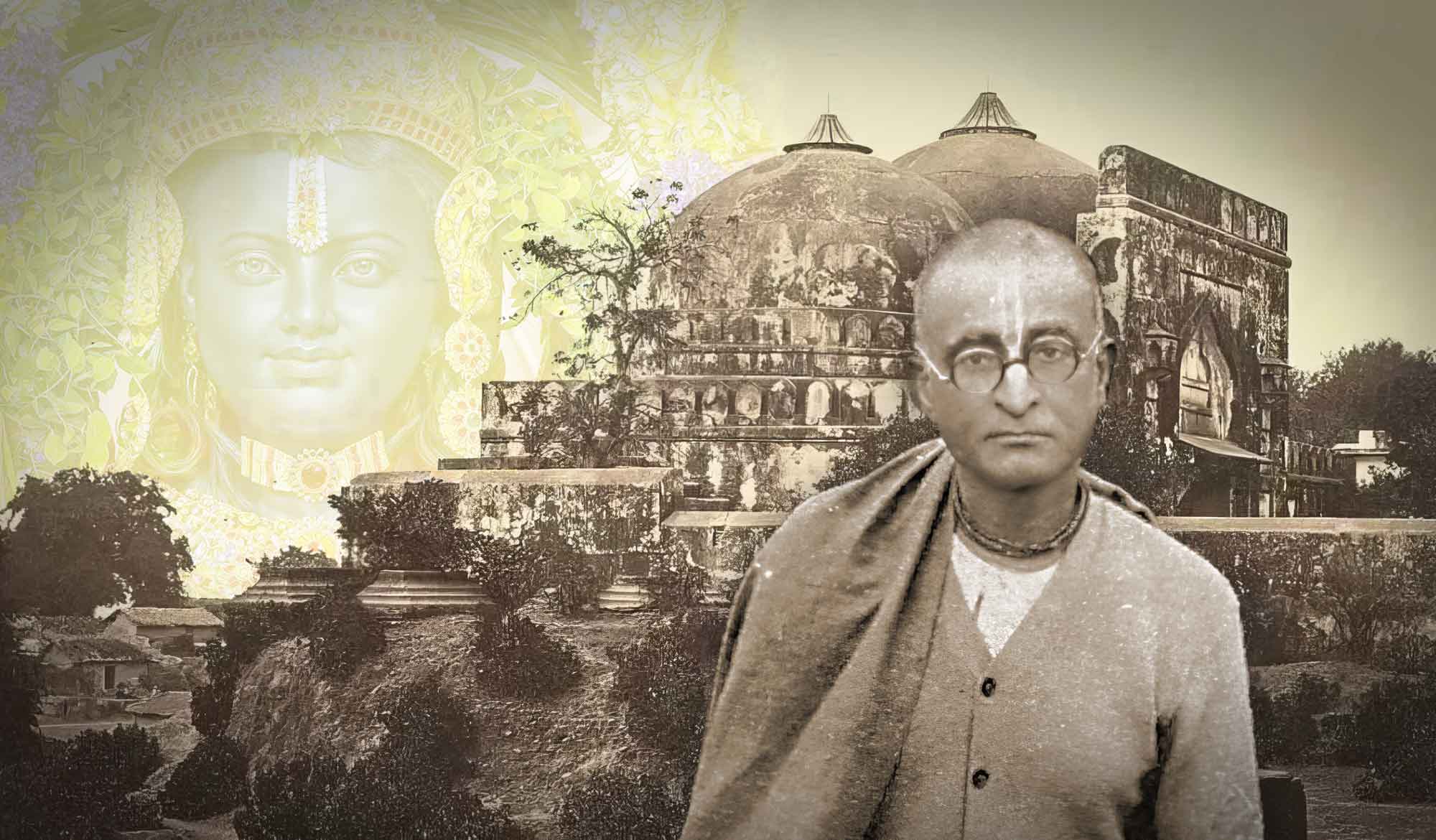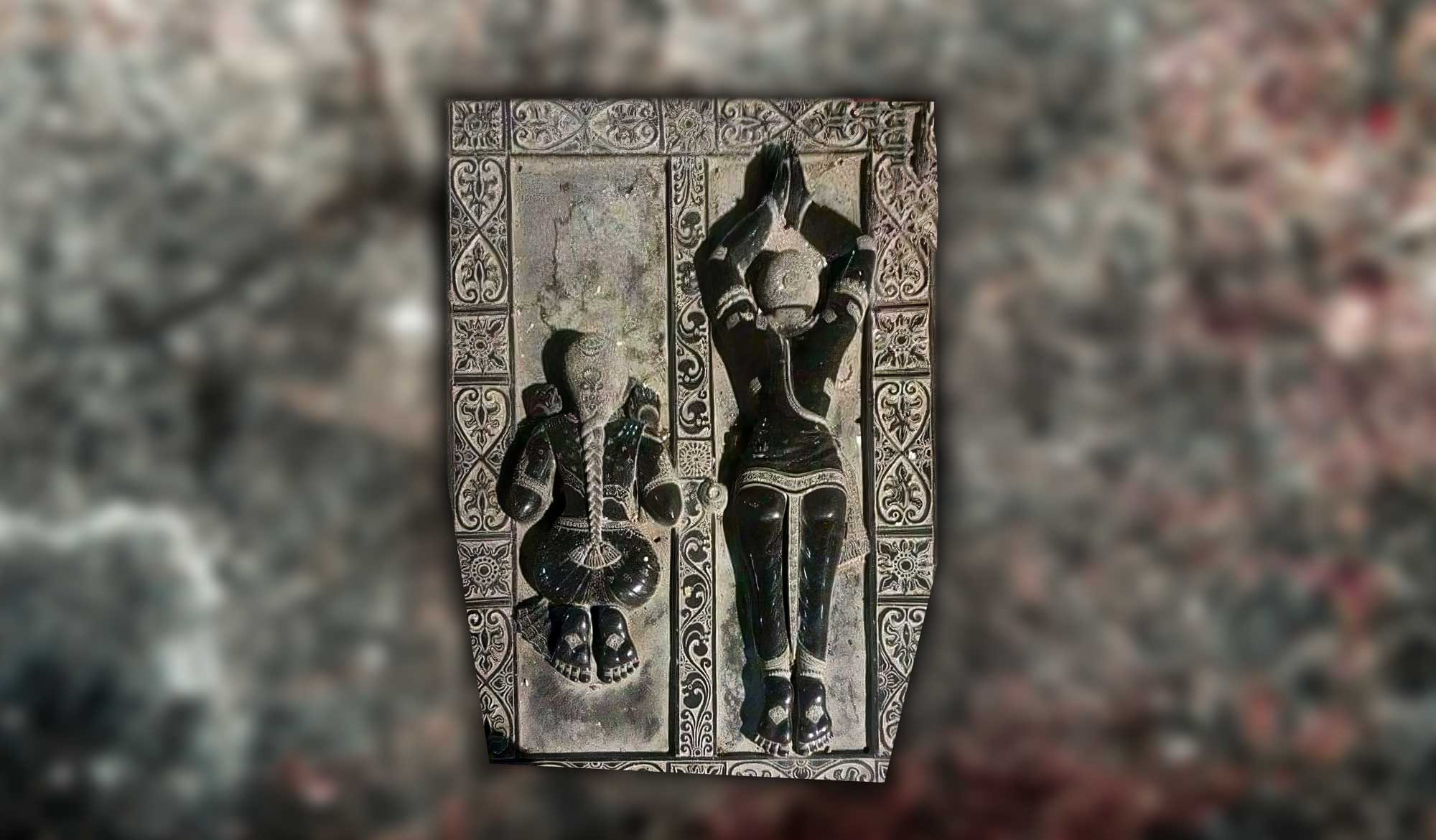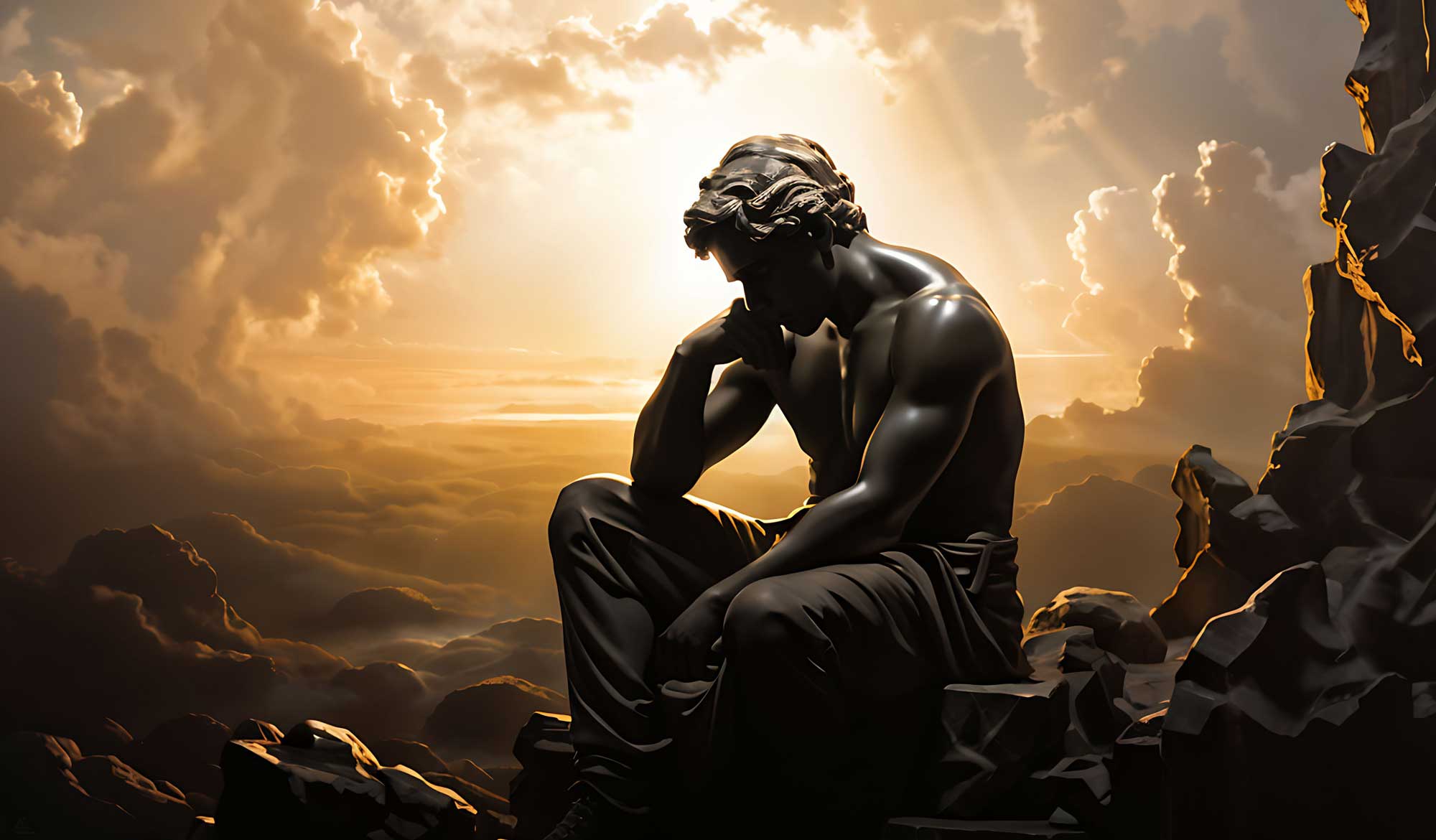Overview
Śrīla B.P. Purī Mahārāja delves into the ontology of Rādhā and Kṛṣṇa according to the Nārada Pañcarātra and other śāstra demonstrating the nature of non-difference between Them. In particular he discusses the supremacy of Śrī Rādhā. This was originally published in Bengali in Śrī Caitanya Vāṇī, 16. 7 on 1st September 1976 and translated by Swami B.V. Giri and Sanātana Dāsa.
In the text of Śrī Nārada-Pañcarātra, in the Second Rātra, Sixth Chapter, it is written – “Just as Śrī Kṛṣṇa is the universal father, Śrī Rādhā is the universal mother. Both of them are fundamentally the same. Just as milk and its whiteness are non-different, similarly there is no difference between Them. Śrī Rādhā, who resides at the chest of Śrī Kṛṣṇa, is like the left part of His body. Śrī Rādhā is situated at the chest of Śrī Nārāyaṇa as Mahā-Lakṣmī, She is the mother of Vibudha as Śrī Sarasvatī, She is the daughter of the ocean of milk (kṣiroda-sindhu) situated at the chest of Śrī Viṣṇu as Śrī Lakṣmī Devī, again She is situated in Brahmaloka on the chest of Śrī Brahmā as Śrī Sāvitrī Devī. In ancient times Devī appeared as the personification of Śrī Hari’s mercy as Bhagavatī by the power of the demigods and after annihilating the demons, gave Indra, the king of the Devas, his kingdom back safely. By the order of Śrī Kṛṣṇa that eternal Bhagavatī, the illusory potency of Viṣṇu, later appeared in the form of Satī, the daughter of Dakṣa. Again after leaving her body due to hearing blasphemy of her husband, she appeared as Pārvatī, the daughter of Himādrī, who is the very personification of all power and the destroyer of all obstacles Durgā Devī. It is only Śrī Rādhā who is the very personification of the supreme intelligence and wealth of Paramātmā Śrī Kṛṣṇa; it is only She who is the personified Svarga-Lakṣmī, who dwells in the residence of Indra in the heavenly planets; She is Rāja-Lakṣmī who resides in the houses of kings of this earth, She is Gṛha-Lakṣmī who dwells within the homes of ordinary people, She is the village-goddess of various villages, She is source of truth found in water (satya-svarūpā), She is the source of smell within the earth (gandha-rūpā), the source of sound within ether (śabda-rūpā) and the source of beauty (śobha-rūpā) in the moon. She is lustre and the source of lustre found in the sun and great kings; She is the burning potency of fire and the personification of all strength found in the living beings. During the time of creation that Goddess is the principal controller of material nature (mūla-prakṛti-iśvarī) – She is the mother of Mahā-Viṣṇu. Mahā-Viṣṇu is great and all-expansive – all the universes manifest from the pores of His body, hence He is naturally famous as ‘Vāsu’ and since His Lord is Śrī Kṛṣṇa, He is famous as ‘Vāsudeva’.”
Therefore, one Kṛṣṇa, due to His various pastimes, manifests infinite numbers of different forms. There is no difference between the powerful (śaktimān) and the power (śakti). The only distinguishing characteristic is that the Power is under the control of the Powerful. Just as Śrī Kṛṣṇa is the male fountainhead (aṁśī), the Lord of lords (sarveśvareśvara) and the primeval Svayam-Bhagavān (original Godhead), similarly, Śrī Rādhā is the female fountainhead (aṁśinī) who is the main reservoir of all potencies – She is the Svarūpa-śakti (the highest potency of the Lord), Svayam-rūpā (the original feminine form) and Svayam-bhagavatī (the original Goddess). Śrī Kṛṣṇa is completely powerful (pūrṇa-śaktimān) and Śrī Rādhā is the complete potency (pūrṇa-śakti). In Vraja the second bodily expansion of Svayam-rūpa Śrī Kṛṣṇa is the original Saṅkarṣana, Svayam-prakāśa Śrī Baladeva. This Kṛṣṇa-Balarāma of Vraja manifest Their aiśvarya (opulence) as the first catur-vyūha in Dvārāka, namely Śrī Vāsudeva, Saṅkarṣana, Pradyumna and Aniruddha. In Mahā-Vaikuṇṭha this manifests as the second catur-vyūha. In this second catur-vyūha, Śrī Balarāma takes the form of Mahā-Saṅkarṣana, whose partial representation is the first puruṣāvatāra, Kārāṇābdhiśāyī who is lying on the Causal Ocean. He is the principal cause of the countless material universes. He then fills up half of every universe with water emanating from the pores of His body and in that He manifests Svetadvīpa where He lies on the bed of Śeṣaśāyī. As He lies there, Lakṣmī-devī serves His lotus feet. He is becomes Garbhodaśāyī – the second puruṣāvatāra. From the lotus emanating from His navel, Brahmā is born. He again becomes the third puruṣāvatāra lying on the ocean of milk – the Paramātmā within the hearts of every individual living being in the material universe. The second puruṣāvatāra, Garbhadakaśāyī, enters every universe as the indwelling Paramātmā of the collective living beings (samaṣṭi-jīva), and the first puruṣāvatāra, Kārāṇādakaśāyī, is the indwelling Paramātmā of all living entities of the countless collective universes.
Thus, one Kṛṣṇa, by the effect of His acintya-śakti (inconceivable potency) has manifested His catur-vyūha forms – He also manifests in infinite forms such as Brahmā, Viṣṇu, Maheśvara etc. The non-dual eternal form of the Absolute appears as the sound of the one-syllabled praṇava (oṁ) and, although it expands into many syllabled forms such as Sri Gopāla, Rāma etc. those various forms are based on knowledge of the one non-dual Absolute.
vadanti tat tattva-vidas tattvaṁ yaj jñānam advayaṁ
brahmeti paramātmeti bhagavān iti śabdyate
“Seers of the truth state that the non-dual knowledge of the Absolute is referred to as Brahman, Paramātmā, and Bhagavān.” (Bhāg.1.2.11)
This interpretation from the Bhāgavata should be followed. The Śrī Gopāla-tāpanī Śruti has also said:
ekam-evādvitīyaṁ brahma māyayā tu catuṣṭayaṁ
“The Lord, who is one without a second, by His potency expanded Himself into four.” (Gopāla-tāpanī Upaniṣad 2.67)
This means that that Absolute Truth, who is one without a second, by His own eternal potency, has manifested the catur-vyūha. The syllable ‘a’ of the praṇava manifested Rāma, the son of Rohiṇī. The syllable ’u’ has given rise to Pradyumna and from the syllable ‘m’ Aniruddha appeared. The syllable ‘a’ presides over all and represents the awakened state (jāgrata). The syllable ‘u’ presides over the dream state (svapna), and the syllable ‘m’ corresponds with state of sleep (suṣupti). But Kṛṣṇa is turīya-vastu – He is transcendental to the aforementioned three conditions of jāgrata, svapna and suṣupti. He is the inexplicable half-syllable that cuts off the vowel, the complete sound of the praṇava and the Complete Absolute (pūrṇa-brahma). The whole universe rests upon Him, the ever blissful Kṛṣṇa.
Due to the nature of non-difference between the Powerful and the Power, Śrī Rukmiṇī is like Kṛṣṇa and is the Creator of the universe (jagat-kartrī) – the giver of all wealth (sarva-sampad-dayinī), the basis of material nature (mūla-prakṛti) and the Lord’s highest potency (svarūpa-śakti). Due to her identification with Śrī Kṛṣṇa, she is also worshiped through praṇava and represented by it. Once Rukmiṇī is presented, then Śrī Rādhā is automatically presented. In the Skanda and Matsya Purāṇas it is mentioned:
rukmiṇī dvāravatyāṁ tu rādhā vṛndāvane vane
“Rukmiṇī is in Dvārāka what Rādhā is in the forest of Vṛndāvana.”
It is said in the Ṛk Pariṣiṣṭha:
rādhāya mādhavo devo mādhavenaiva rādhikā
vibhrājante jāneṣu
“Among all persons, it is Rādhā in whose company Mādhava is especially glorious, as She is especially glorious in His.”
For this reason, it is mentioned in the Nārada-pañcarātra that during the time of the creation of the universe, Mūla-prakṛti-īśvarī, the primeval goddess of material nature (Śrī Rādhikā Herself) gave birth to the Mahā-Virāṭ-Puruṣa, Kārāṇābdhaśāyī Mahā-Viṣṇu, who is the cause of infinite numbers of universes. In the Brahma-vaivarta Purāṇa, Prakṛti-khanda, (2nd and 3rd Chapters), the description of the appearance of Mahā-Viṣṇu has been given in this way –
“At the beginning of the entire creation, Śrī Kṛṣṇa, desiring to create by His own will, divided Himself into two. From the left part of His body He assumed the form of a beautiful woman and from the right part He assumed a male form – in other words, He manifested the forms of Śrī Rādhā-Kṛṣṇa. After this, They performed rasa in the rāsa-maṇ∂ala for a period of Brahmā’s lifetime. (rāsa-krī∂aṁ cakāra ha yāvad vai brahmaṇo vayaḥ). Rādhā, who is situated in the heart of Kṛṣṇa, who is more dear to Kṛṣṇa than His own life, delivered an egg after being pregnant through Kṛṣṇa for a period of one hundred manvantaras. Seeing that egg She became morose and when She threw it into the water, Kṛṣṇa cursed Her that, “Because You have abandoned Your offspring, henceforth You can never have any children. However, although You will be bereft of offspring, You will remain eternally young. The manifestations that take birth from You will also be barren, but for eternity they will also possess vitality and youth.”
Thereafter, from the tip of the Goddess Rādhā’s tongue, the white complexioned Sarasvatī-devī, the goddess of all scriptures, appeared dressed in yellow garments and holding a vīṇā and books. Then Rādhārāṇī further divided and Kamalā-devī (Lakṣmī) appeared from Her left side. The right part of Her remained as the form of Rādhā. Seeing this, Kṛṣṇa also divided His form. His right half remained as the two-handed Kṛṣṇa, His left half manifested the four-handed Nārāyaṇa. By the will of Kṛṣṇa, and by the will of Sarasvatī and Rādhārāṇī, Lakṣmī became the consort of Nārāyaṇa. Nārāyaṇa went to Vaikuṇṭha. Due to being manifest from Śrī Rādhā, Lakṣmī and Sarasvatī remained childless. After this, from the limbs of Nārāyaṇa, many four-handed associates, who were as effulgent as Viṣṇu, were born. From Kamalā-devī’s limbs millions and millions of maidservants manifested. All of them became companions of Lakṣmī. Then, from the pores of Śrī Kṛṣṇa’s body, innumerable gopas appeared and from the pores of Śrī Rādhā’s body, innumerable gopikās were born. However, due to Kṛṣṇa’s curse, they were all childless. Then, from the limbs of Kṛṣṇa, Durgā-devī appeared, who is known as Sanātanī (the eternal one), Viṣṇu-māyā (the potency of Viṣṇu), Nārāyaṇī (the energy of Nārāyaṇa) and ˆśānī (she who fulfils all desires). It is her illusory potency that has bewildered the three worlds. After this, from the lotus-navel of Śrī Kṛṣṇa (from Garbhodaśāyī) appeared four-headed Brahmā and on his left was a woman of unparalleled beauty (Sāvitrī). This husband and wife chanted many prayers to Kṛṣṇa. Then Kṛṣṇa further divided Himself and His left part became Mahādeva, while His right part remained the same as the Lord of the gopipīkās. Mahādeva, with his five mouths, started kṛṣṇa-nāma kīrtana.
Meanwhile the egg, after remaining in the water for a lifespan of Brahmā, split in two and from within a beautiful child emerged as effulgent as millions of suns combined, and feeling the pangs of hunger, He began to cry. This was the Master of countless material universes, Kārāṇābdhiśāyī Mahā-Viṣṇu. In every universe there is a Brahmā, Viṣṇu and Śiva existing. Therefore He is the Master of each and every Brahmā, Viṣṇu and Śiva within all those countless universes. Goloka and Vaikuntha are the only two places that are eternal. All the material universes are of a transitory existence just like a drop of water. Mahā-Viṣṇu, after attaining knowledge, began meditating on Śrī Kṛṣṇa. Kṛṣṇa appeared before Him and blessed Him with a boon of becoming equally knowledgeable as Himself and being free from disease, lamentation, old age, death etc. Śrī Kṛṣṇa also gave Him the supreme secret six-syllable mahā-mantra – oṁ kṛṣṇāya svāhā in His right ear and advised Him to continuously meditate on His mother, the chaste Śrī Rādhikā. Simply by the glance of Mahā-Viṣṇu, prakṛti is activated and gives birth to all that is animate and inanimate in this material world. It is He, in the form of Garbhodaśāyī that accepts Brahmā on His lotus navel. It is from His forehead that the eleven Rudras manifest etc.”
Thus many similarities can be seen between the statements of Śrī Nārada-pañcarātra and the Brahma-vaivarta Purāṇa. In Śrī Viṣṇu Purāṇa this Brahma-vaivarta Purāṇa has been termed as the tenth Purāṇa – daśamaṁ brahma-vaivartam.
In the aforementioned Śrī Nāradīya it is written –
adau samucchared rādhāṁ paścāt kṛṣṇañca mādhavam
viparītaṁ yadi paṭhet brahma-hatyāṁ labhed dhruvam
śrī kṛṣṇo jagatāṁ tāto jagan-mātā ca rādhikā
pituḥ śata-guṇaiḥ mātā vandyā pujyā garīyasī
(Nārada-pañcarātra, 2nd Rātra, 6th Chapter, Verses 6-7)
This means that after pronouncing the word ‘Rādhā’ one should pronounce the word ‘Kṛṣṇa’ or ‘Mādhava’ (mā means Lakṣmī, dhava means ‘Lord’, thus Mādhava means ‘the Lord of Lakṣmī’). If someone chants it in the opposite way, he will surely incur the reaction of killing a brāhmaṇa. Śrī Kṛṣṇa is the Supreme Father of the universe. Śrī Rādhikā is the Supreme Mother of the universe. The mother is a hundred times more respectable, worshippable and honourable than the father.
Related Articles
- Śrī Śrī Rādhā Kṛṣṇa & The Fountainhead of All Tattvas by Śrīla Bhakti Pramoda Purī Gosvāmī
- A Prayer Composed on the Occasion of the Disappearance of Śrīla Gadādhara Paṇḍita by Śrīla Bhakti Pramoda Purī Gosvāmī
- The Appearance of Śrīla Gadādhara Paṇḍita by Śrīla Bhakti Rakṣaka Śrīdhara Deva Gosvāmī
- Śrī Śarādīyā Pūjā by Śrīla Bhakti Rakṣaka Śrīdhara Deva Gosvāmī
- Śrī Lalitā Devī and Śrīmatī Rādhārāṇī by Śrīla Bhakti Rakṣaka Śrīdhara Deva Gosvāmī
- The Appearance of Rādhā-kuṇḍa by Śrīla Bhakti Rakṣaka Śrīdhara Deva Gosvāmī
- From Śraddhā to Prema by Śrīla Bhakti Gaurava Narasiṅgha Mahārāja
- Gāyatrī as Rādhārāṇī by Śrīla Bhakti Gaurava Narasiṅgha Mahārāja
- My Guru is Rādhārāṇī by Śrīla Bhakti Gaurava Narasiṅgha Mahārāja
- The Greatest Negative by Śrīla Bhakti Gaurava Narasiṅgha Mahārāja
- Śrī Rādhāṣṭamī by Śrīla Bhakti Gaurava Narasiṅgha Mahārāja
- Śrīla Śrīdhara Mahārāja and the Gem of All Conceptions by Śrīla Bhakti Gaurava Narasiṅgha Mahārāja
- Planets of Faith by Śrīla Bhakti Gaurava Narasiṅgha Mahārāja
- Rādhā-Pāda Darśana by Śrīla Bhakti Gaurava Narasiṅgha Mahārāja
- The Definition of Faith by Gaura Gopāla Dāsa
Further Reading
Prema Dhāma Deva Stotram with the Narasiṅgha Sevaka Commentary – Verses 61-65
In verses 61 to 65 of 'Prema Dhāma Deva Stotram', Śrīla Śrīdhara Mahārāja narrates the pastime of Śrī Caitanya at Caṭaka Parvata In Purī and explains how the scriptures produced by Brahmā and Śiva are ultimately searching for the personality of Mahāprabhu who is merciful too all jīvas, no matter what their social position.
Prabhupāda Śrīla Sarasvatī Ṭhākura’s Visit to Ayodhyā
With the forthcoming observance of Śrī Rāma Navamī, we present 'Prabhupāda Śrīla Sarasvatī Ṭhākura’s Visit to Ayodhyā' written by Śrīla Bhaktisiddhānta Sarasvatī Ṭhākura Prabhupāda from The Gaudīyā magazine, Vol 3. Issue 21/ In December 1924, after visiting Benares and Prāyāga, Sarasvatī Ṭhākura visited the birth-site of Śrī Rāmācandra in Ayodhyā.
Śaraṇāgati – The Only Path to Auspiciousness
In this article, 'Śaraṇāgati - The Only Path to Auspiciousness', Dhīra Lalitā Dāsī analyses the process of śaraṇāgati (surrender) beginning with śraddhā (faith). She also discusses the role of śāstra and the Vaiṣṇava in connection with surrender.
Ātma Samīkṣā – The Value of Introspection
In this article, "Ātma Samīkṣā – The Value of Introspection" Kalki Dāsa highlights the importance of introspection in the life of a devotee and especially in relation to the worldly environment that surrounds us. He also explains how transcendental sound influences our capacity to introspect.
Prema Dhāma Deva Stotram with the Narasiṅgha Sevaka Commentary – Verses 61-65
In verses 61 to 65 of 'Prema Dhāma Deva Stotram', Śrīla Śrīdhara Mahārāja narrates the pastime of Śrī Caitanya at Caṭaka Parvata In Purī and explains how the scriptures produced by Brahmā and Śiva are ultimately searching for the personality of Mahāprabhu who is merciful too all jīvas, no matter what their social position.
Prabhupāda Śrīla Sarasvatī Ṭhākura’s Visit to Ayodhyā
With the forthcoming observance of Śrī Rāma Navamī, we present 'Prabhupāda Śrīla Sarasvatī Ṭhākura’s Visit to Ayodhyā' written by Śrīla Bhaktisiddhānta Sarasvatī Ṭhākura Prabhupāda from The Gaudīyā magazine, Vol 3. Issue 21/ In December 1924, after visiting Benares and Prāyāga, Sarasvatī Ṭhākura visited the birth-site of Śrī Rāmācandra in Ayodhyā.
Śaraṇāgati – The Only Path to Auspiciousness
In this article, 'Śaraṇāgati - The Only Path to Auspiciousness', Dhīra Lalitā Dāsī analyses the process of śaraṇāgati (surrender) beginning with śraddhā (faith). She also discusses the role of śāstra and the Vaiṣṇava in connection with surrender.
Ātma Samīkṣā – The Value of Introspection
In this article, "Ātma Samīkṣā – The Value of Introspection" Kalki Dāsa highlights the importance of introspection in the life of a devotee and especially in relation to the worldly environment that surrounds us. He also explains how transcendental sound influences our capacity to introspect.


